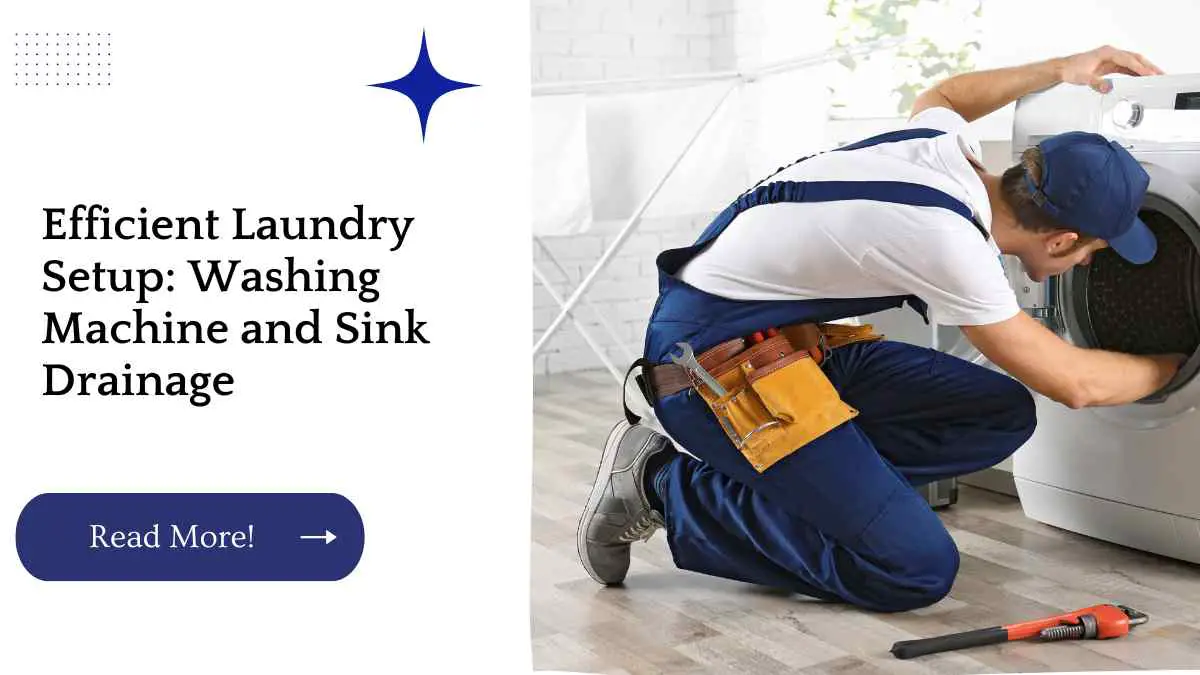Laundry is a necessary task that we all have to do, but it can be time-consuming and tiring. An efficient laundry setup can save time and energy while ensuring that your clothes are clean and fresh. In this blog post, we will focus on the washing machine and sink drainage system, two critical components of an efficient laundry setup.
| Key Takeaways |
|---|
| An efficient laundry setup can save time and energy. |
| Choosing the right washing machine is crucial for optimal performance. |
| Setting up the washing machine involves leveling it, connecting the water supply and drainage hose, and testing it. |
| Sink drainage is important for preventing flooding and ensuring the proper functioning of the washing machine. |
| Troubleshooting common problems can help maintain an efficient laundry setup. |
| Regular maintenance and cleaning can extend the life of the washing machine and improve its performance. |
The Importance of an Efficient Laundry Setup
An efficient laundry setup can save you time, money, and energy. A poorly functioning washing machine can take longer to clean clothes and use more water and energy, resulting in higher utility bills.
An inefficient drainage system can lead to flooding and water damage, which can be costly to repair. A well-designed laundry setup can also improve the overall aesthetic of your home.
Choosing the Right Washing Machine
Choosing the right washing machine is crucial for an efficient laundry setup. When selecting a washing machine, consider the size of your household, the type of fabric you will be washing, and your budget. Front-loading washing machines are generally more efficient than top-loading ones, but they can be more expensive.
Is your washing machine draining into the sink? Don’t worry, our guide on fixing this issue can help you redirect the drainage to the plumbing system.
Setting Up the Washing Machine
Once you have selected the right washing machine, it’s time to set it up for optimal performance.
Leveling the Washing Machine
A washing machine must be level to function correctly. Use a leveling tool to ensure that the washing machine is level in all directions. Adjust the legs of the washing machine if necessary.
Connecting the Water Supply
The washing machine needs a water supply to operate. Connect the water supply hose to the washing machine and the water source. Turn on the water supply and check for leaks.
Don’t have a sink for your dishwasher? No problem! Our plumbing guide for dishwashers can show you alternative ways to set it up and make your efficient laundry design a reality
Connecting the Drainage Hose
The washing machine also needs a drainage system to remove the dirty water. Connect the drainage hose to the washing machine and the sink drainage system. Test the drainage system by running a cycle with a small load of laundry.
Testing the Washing Machine
Once the washing machine is set up, run a test cycle with a small load of laundry to ensure that it is functioning correctly. Check for any leaks or excessive noise.
The Importance of Sink Drainage
Proper sink drainage is crucial for an efficient laundry setup. If the sink drainage system is not functioning correctly, it can lead to flooding and water damage. Make sure that the sink drainage system is clear of any debris or clogs before connecting it to the washing machine.
Prevention is always better than cure. Check out our plumbing tips to prevent leaks before setting up your efficient laundry to save time and money in the long run
Connecting the Sink Drainage System to the Washing Machine
Connecting the sink drainage system to the washing machine is easy. Attach the drainage hose of the washing machine to the sink drainage system using a Y-shaped connector. This will allow the dirty water from the washing machine to flow directly into the sink drainage system.
Troubleshooting Common Problems
Even with proper setup, problems may still occur. Here are some common issues and how to troubleshoot them.
Clogged Drainage System
If the drainage system is clogged, it can cause the washing machine to overflow or stop working. To fix this issue, remove any debris or clogs from the sink drainage system and the drainage hose.
Leaking Water Supply Hose
If the water supply hose is leaking, it can cause water damage to your laundry room. Turn off the water supply and replace the hose.
Struggling with a loose adapter in your plumbing system? Our helpful fix using a simple guide can provide the solution and help you set up your efficient laundry with ease.
Uneven Washing Machine
If the washing machine is uneven, it can cause excessive noise and vibration. Adjust the legs of the washing machine to ensure that it is level.
Excessive Noise
If the washing machine is making excessive noise, it could be due to a faulty part or uneven load. Check for any loose parts or unbalanced loads.
Maintenance and Cleaning Tips
Regular maintenance and cleaning can extend the life of your washing machine and improve its performance.
Cleaning the Washing Machine
Clean the washing machine regularly to remove any dirt or debris that may be clogging the system. Use a mixture of vinegar and baking soda to clean the interior of the washing machine.
Cleaning the Drainage System
Clean the drainage system regularly to prevent clogs. Use a mixture of hot water and baking soda to clear any debris.
Further Reading
Here are some additional resources to help you set up an efficient laundry room:
How to Set Up Laundry Room Plumbing: This article from Better Homes & Gardens provides a step-by-step guide to setting up the plumbing in your laundry room.
How to Install a Utility Sink Next to Washer: This article from PalmGear explains how to install a utility sink next to your washer for added convenience.
How to Install a Washing Machine: The Home Depot provides a comprehensive guide to installing a washing machine, including tips on leveling and connecting the water supply and drainage hose.
Conclusion
An efficient laundry setup requires a well-functioning washing machine and sink drainage system. Choosing the right washing machine, setting it up properly, and troubleshooting common problems can help maintain an efficient laundry setup.
Regular maintenance and cleaning can also extend the life of your washing machine and improve its performance. By following these tips, you can ensure that your laundry is done efficiently and effectively.
Leaky sink drains can cause headaches, but fixing them doesn’t have to be complicated. Our DIY solutions guide for fixing leaky sink drains can help you troubleshoot the issue while setting up an efficient laundry.
FAQs
What is an efficient laundry setup?
An efficient laundry setup involves a well-functioning washing machine and sink drainage system, which can save time, energy, and money.
How do I choose the right washing machine for my household?
Consider the size of your household, the type of fabric you will be washing, and your budget when choosing a washing machine.
Why is sink drainage important for a washing machine?
Proper sink drainage is crucial for preventing flooding and ensuring the proper functioning of the washing machine.
What are some common problems with washing machines?
Common problems with washing machines include clogged drainage systems, leaking water supply hoses, uneven machines, and excessive noise.
How do I maintain my washing machine?
Regular maintenance and cleaning can extend the life of your washing machine. Clean the washing machine and drainage system regularly to prevent clogs and remove any debris.

Hellen James is the author of the blog and a licensed plumber with over 15 years of experience. She shares her knowledge and experience in plumbing and drainage through insightful and informative articles

